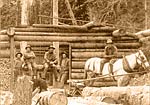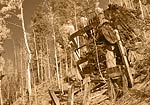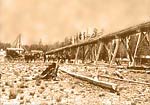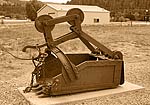






The pursuit of gold and silver dominated the flow of commerce. Names like Gilt Edge Placer, Golden Treasure, Junebug, Silver Queen, Jayhawk, Inferno, Independence and the Black Copper would stir the spirits of the rainbow chasers who came to the isolated valley in search of a future. Most of the seekers, however, were not professional miners but rather shopkeepers, school teachers, farmers and store clerks who had lost everything in President Cleveland’s recession and had nothing left to lose. Most didn’t even know what real gold looked like, mistaking the shiny pyrite for the real thing.
By the time Red River City got into the full sway of gold fever, the days of striking it rich with a glorious “find” were no longer the way to wealth for individuals in the mines of the American West. To discover a promising site was one thing, but to develop it properly required money. Large companies capable of investing working capital purchased the claims of hard rock miners. A good example was the 1897 sale by Harry Brandenburg of his share in the Black Copper. The $4000 he received was sizable for the time, and the Black Copper only officially produced $200,000 in pay ore, but at great expense to the investors who eventually abandoned their investment.
The glory days of Red River City were brief. Low grade ore and costs of processing which required transportation to places like Pueblo, Colorado, proved to be anything but cost efficient. Add the hardship of hard rock mining which was complicated by ground water which flooded tunnels and shafts. By 1897 many miners had moved on to other gold fields, like Cripple Creek, Colorado and the Klondike in Alaska.
By 1905, the population which had once been touted as 1,500 to 3,000 souls dwindled to 150. Mining did not completely die in the area and a surge of interest preceded the outbreak of World War I, which generated some outside investment, most noticeably with the Buffalo Mine and the Caribel. The revival, however, did not survive the war and only a handful of hardy individuals like Pete Del Dosso and Carl Purkapile “kept the faith” of the hardrock miner and worked various prospects with little success.
Today, only traces of those glory days can still be seen, remnants of an exciting time in the history of the valley. The Red River of the 21st century relies on providing hospitality, relaxation and a break from the ordinary. The pieces of the past, however, that can still be seen in the canyons and along the banks of the chilly mountain streams offer a chance to step back in time, a time so different, yet so like our own days of dreams and aspirations.
J. Rush Pierce & Royce Raven
(Kerry Shepherd - Website Designer)
(Kerry Shepherd - Website Designer)






